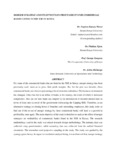MERGER STRATEGY AND ITS EFFECTS ON PROFITABILITY FOR COMMERCIAL BANKS LISTED IN THE NSE IN KENYA

View/
Date
2019-04Author
Warui, Stephen Kamau
Njeru, Phelista
Gongera, George
Bichanga, Julius
Metadata
Show full item recordAbstract
For some of the commercial banks that are listed in the NSE in Kenya, merger strategy has been
previously used, more-so to grow their profit margins. But for the past two decades, these
commercial banks have been experiencing a lot of economic turbulence. The business environment
has changed, which has led to an influx of banks in the country, the result of which is increased
competition. This has not been made any simpler by the introduction of lowered interest rates in
terms of loan-rates (a result of the government introducing the Capping Bill). Therefore, as an
alternative strategy to closing down of branches and retrenching employees, this study seeks to
find out if the re-use of merger strategy by these commercial banks will lead to a growth in
profitability once again. The main objective of the study is therefore to analyze the effect of merger
strategies on profitability of commercial banks listed in the NSE in Kenya. The research
methodology used in the study was mixed research design methodology. The primary data was
collected using questionnaires; while secondary data was collected from the audited financial
statements. The researcher used purposive sampling in the study. The study was guided by the
synergy-gains theory. In regard to correlation analysis being, it was observed that, merger strategy and ROA (after merger) had a positive and significant relationship. In regard to the regression
analysis, the calculated p-value was 0.018, which was lower than the critical p-value of 0.05 for
the study. This led to the researcher rejecting the null hypothesis that there was no significant
relationship between merger strategy and profitability for commercial banks listed in the NSE. For
primary data, using the five-point Likert scale, the responses average mean was found to be 3.75.
This meant that, majority of the respondents agreed with the questions that were asked in the
questionnaire for the study, which led to the conclusion that, merger strategies had significant
effect on the profitability of commercial banks listed in the NSE. Therefore, a conclusion that the
use of merger strategies by commercial banks listed in the NSE led to a growth in their profitability
was drawn.
